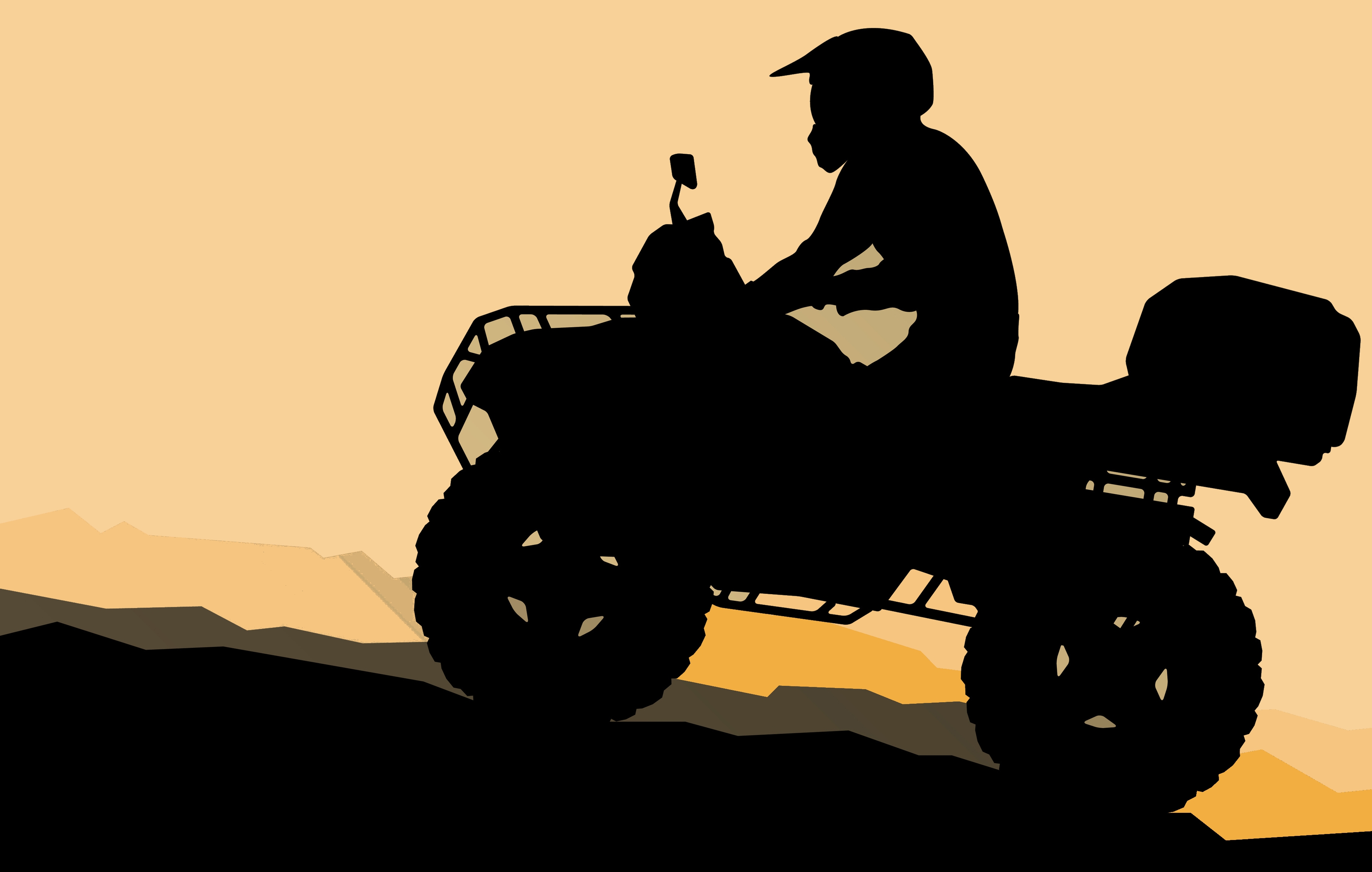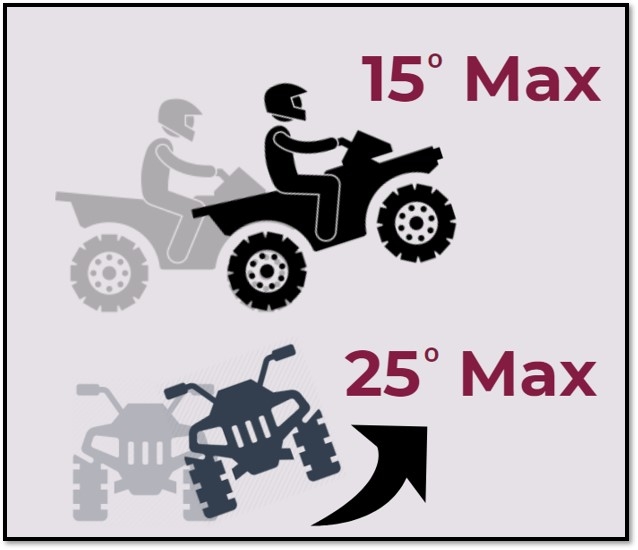Module 2: All-Terrain Vehicle Safety

All-Terrain Vehicles (ATVs) play a large role on today's farm. As such, we find ATV-related injuries and fatalities to be increasing. Overall (occupational / recreationally), an average of 500 persons die and another 100,000 are seriously injured each year while operating ATVs. Within occupations that use ATVs, the agricultural indusrty claims 60% of ATV related fatatlities.
There are basic safety principles apply to all ATV operations, whether used for personal or work purposes.
Control Your Speed
Speed is a major contributor to ATV injuries and fatalities. Higher speeds reduce your ability to react to changes in condition or terrain. Speed, when cornering, affects your center of gravity and increases the risk of a rollover.
Wear Your Helmet
Wearing a DOT or Snell certified helmet is the single most important step you can take to reduce the risk of being fatally injuried when riding an ATV. Other types of helmets do not provide sufficient face and head protection. It can be a life-saver!
Know Your Terrain
Know where you're going. Terrain can change quickly and you may not be able to react. If you drive over new terrain, go slow until you know. Be aware of other hazards such as:
- Old wire fencing
- Broken fence posts or downed trees
- Rocks
- Tree roots/stumps
- Creeks, streams, and culverts
- Holes created by wildlife
- Paved roads
Avoid Steep Slopes
Know what your ATV is capable of doing by reviewing the operators manual. Stay within your ATV's suggested operating range. Slopes more than 15 degrees greatly increase the risk of rollover. Attachments and extra loads change the center of gravity and increase your risk. Until you are familar with the handling of your ATV, use caution. Understand the center of gravity for the ATV.
Click here for our ATV Poster or our ATV Label.
ATVs & State Laws
Laws regarding ATVs and their safe use vary widely from state to state. If you are operating an ATV while employed, the Occupational Safety and Health Administration (OSHA) provides general guidance.
Off-Road Vehicle Rules of the Road
The Virginia Department of Motor Vehicles (DMV) requires that new ATVs or off-road motorcycles powered by a gasoline or diesel engines displacing more than 50 CCs must be titled.
- ATVs and off-road motorcycles are not required to be registered.
- You may title a used ATV or off-road motorcycle or any reason, including recording a lien or documenting proof of ownership.
Operating Requirements for ATVs and Golf Carts
You must be 16 years or older to operate an ATV. However:
- Children between the age of 12 and 16 may operate ATVs if powered by engines displacing no more than 90 CCs.
Children under 12 may operate ATVs powered by engines displacing no more than 70 CCs
It is illegal to operate ATVs on any public highway or other private property, unless proper authorities allow it to:
- Cross a public highway by the most direct route;
- Be operated by law-enforcement officers, firefighters, or emergency medical services responding to emergencies.
Any person operating an ATV vehicle must wear a protective helmet.
It is illegal to operate a golf cart on any public highway unless proper authorities designate that portion of public highway for golf cart use.
OSHA & ATVs
While OSHA does not have a direct regulatory requirement governing ATV safety or use by employees, the General Duty Clause 5 (a)(1) requires employers to provide a workplace free from recognized hazards likely to cause death or serious physical harm. They also provide information regarding general hazards and guidance here.
One of the biggest things to do is to read and follow the Owner’s Manual for the ATV you have. Other reasonable steps to take include:
- Perform routine safety checks on equipment;
- Ensure all operators have appropriate training. Include supervised sessions to help operators gain experience;
- Provide appropriate personal protective equipment, and ensure it’s used properly;
- Ensure operators have correct information on load and weight limitations; and,
- Establish safe work practices for crossing roads or highways and working alone.

Recognize the Hazards of the ATV
ATV safety is largely dependent on operator behavior. Any ATV can be unstable and pose a higher risk when operated in an unsafe manner.
These are some common elements of serious injuries and fatalities in work-related ATV accidents.
- Speeding
- Operating the ATV on a paved road
- Not wearing a protective helmet
- Operating the ATV while overloaded or with an unbalanced load
- Carrying passengers on single rider ATVs.
Terrain can be a factor in ATV incidents. Specific terrain types or obstacles that can contribute to injury or death of an ATV operator include:
- Holes and ruts.
- Trees, stumps or large rocks.
- Fencing and wires.
- Creeks, culverts and streams.
Rollovers are among the most common types of incident. Rollovers can be attributed to things that alter an ATVs center of gravity.
Things that can impact the center of gravity include:
- Excessive speed while turning or on rough terrain.
- Overloading the ATV or having an unstable loads, including using unbaffled tanks.
- Altering the ATV or cargo bed configuration.
Rollovers are often the result of riding on hilly terrain. Climbing or descending grades of 15º or more is strongly discouraged by ATV manufacturers.

Crossing side slopes is discouraged unless absolutely necessary. Most manufacturers agree that side slopes of 25º or more greatly increase rollover risk.
Operation on Paved Roads
ATVs are specifically designed for off-road use; therefore using on roadways creates an additional hazard. ATVs are more difficult to control on pavement or concrete due to their low pressure tires, steering and suspension.
If you have to cross a public roadway in Virginia, always cross a highway by the most direct route, and where there is good visibility for both you and vehicles using the road.

Modifications & Attachments
Always review the Owner’s Manual for loading or pulling operations, and for the use of any attachments or modifications.

Never exceed weight limits specified in the Owner’s Manual!
Working Alone
Farm workers frequently work alone where there is no direct contact with the employer or co-workers. This can happen when herding livestock or otherwise tending to animals, maintaining fences, or simply doing head counts.
Evaluate the Hazards
- Know the terrain.
- Know the capabilities of the ATV, especially if you are carrying a load.
- Perform a pre-use inspection.
- Have a plan for severe weather.

Control the Hazards
Rollovers can be prevented by:
- Adjust your speed for turns, obstacles, and the terrain.
- Know how to operate your ATV in various types of rough terrain.
- Know your load and how it affects the center of gravity.
- Operate safely on slopes and inclines; stay within the manufacturer’s safety guidelines.
- Ensure loads are stable and secured.
- Stay within the weight limits for your ATV
- Use only manufacturer-approved accessories.
Rollover Protective Systems (ROPS) provide protection from crushing in the event a piece of equipment overturns. ROPS are not required but are recommended, since nearly 60% of fatalities occur in rollovers.

ROPS are available from a variety of manufacturers. Check with your ATV manufacturer about retrofitting a ROPS to your ATV.
Active Riding refers to the operator’s ability to make quick body weight shifts combined with acceleration and braking. Active riding is a necessary skill, allowing the operator to effectively steer and control an ATV.
SIPDE is often taught as a model for driver safety:
- S - Scan constantly the area ahead of you
- I - Identify any hazards
- P - Predict how the hazard will affect your operation
- D - Decide what to do
- E - Execute your plan.

Be prepared for unexpected hazards, such as uneven terrain or obstacles, and react appropriately - slow down, stop, or avoid.
Personal Protective Equipment (PPE)
The Consumer Product Safety Commission (CPSC) provides information regarding manufacturer recalls, and safety-related information. ATV operators should always wear a motorcycle or motorsports helmet certified by the U.S. Department of Transportation (DOT) and/or the Snell Memorial Foundation (Snell) when operating or riding on an ATV.
Other recommended PPE may include:
- Long pants with a long-sleeved shirt
- Over-the-ankle boots
- Gloves
- Eye and face protection
Pre-Use Inspections
Always follow the Owner’s Manual for guidance on pre-use inspections. Here's a general checklist to use for inspections if the Owner's Manual is not available for some reason. Inspections generally include:
- Check wheels for damage, and tires for condition and proper inflation.
- Check for proper operation of the throttle, clutch and brake operation, including control cables (if cable-actuated).
- Ensure all lights and electrical systems working properly.
- Check fuel, oil, coolant, and brake or other fluids outlined by the Owner’s Manual.
- Check the air filter and any exhaust system.
- Check the chassis, steering and suspension systems.
Training
Operator training typically consists of three components.
- Generalized classroom training on ATV safe operation, hazard recognition, and local laws or regulations.
- Hands-on familiarization with the unique characteristics of the machine to be operated.
- Operator practice in a controlled environment.
There are excellent, free, online training resources available through the Specialty Vehicle Institute of America (SVIA) at www.svia.org.
Register your ATV with the Manufacturer
Manufacturers notify the registered owner of safety recalls. The U.S. Consumer Product Safety Commission also maintains product recall information, accessible at www.cpsc.gov.
Emergency Planning
- Have a means of calling for help if you will be in a remote area. Cell phone service may be spotty and unreliable.
- Know your location and directions, if necessary.
- When possible, work in groups of two or more, or let someone know where you will be and when to expect you back.



